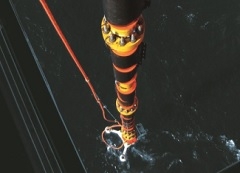- Home page /
- New technologies and equipment /
- Claxton installs HP drilling riser in Gullfaks field
Claxton installs HP drilling riser in Gullfaks field

Claxton Engineering, an Acteon company, managed the project with support from sister companies 2H Offshore, Pulse Structural Monitoring and Subsea Riser Products, who manufactured sections of the riser and supplied the riser spider. The companies jointly delivered a detailed drilling riser solution, bespoke engineering work and a monitoring system to track performance.
This project was in unusually deep water for jackup rigs, as Darren Bowyer, project manager, Claxton, explains: “For jackup operations, deep water is over 80 m. Leg length determines the depth that jackup rigs can operate in but average jackup rigs like the West Elara are for 80-100 m of water, so 132 m was challenging. The main issue is scaling up to the needs of deeper water. Depth increases the current and wave deflection of the jackup rig and the drilling riser, and increases loading on the whole system.”
According to Bowyer, “The industry has little experience of jackup rigs in depths greater than 100 m and in harsh environments. This makes for conservatism in design and operations. Furthermore, during high-pressure operations, well control considerations require a large blowout preventer, which adds a stiff component to the drilling riser and changes the dynamics of the string.”
The alterations to the drilling riser design included adding a vortex-induced-vibration suppression system; using forged rather than welded joints in high-stress and fatigue-prone areas; and upgrading the tensioning system to 500 t.
Bowyer says, “Adding special fairings to reduce vortex-induced-vibration and drag was a first for a high-pressure drilling riser in the North Sea.”
This project was the first use of Claxton’s NT-2 tool for deploying a riser and enabled it to be pressure tested before make-up to the blowout preventer.
Monitoring and integrity management have become key focus areas, so Pulse developed a riser monitoring system to gather field data; enable integrity management; verify the predicted models; and enable the operator to drill safely. The system included topside and subsea sensors for recording movement, load and dynamic bending parameters.

